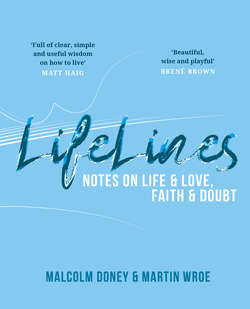Читать книгу LifeLines - Malcolm Doney - Страница 30
На сайте Литреса книга снята с продажи.
Оглавление21
Tune in
George Herbert, the seventeenth-century metaphysical poet, wrote a poem about prayer, ‘Prayer (I)’, without explaining what prayer was. Just as well. ‘Hands together, heads bowed, eyes closed’ doesn’t really do it.
But he hinted at what can happen when people try to pray. And his best hint was simply this: ‘something understood’.
Every now and again. For a second – or less – we luck out on an ‘aha!’ moment. Something understood... even if it remains something we can’t quite explain.
Most faiths involve prayer and while some, like Buddhism, don’t rely on a god, the emerging discipline of ‘mindfulness’ offers a way of ‘prayer’ that doesn’t rely on faith. Prayer is tuning in. Opening ourselves to hearing ‘the tune which all things hear’ as Herbert phrases it. It’s about joining a conversation with whatever or whoever may be within, behind or beyond it all. It’s about another way of being. Herbert calls it: ‘The soul in paraphrase.’1
You can kneel, sit in the lotus position, prostrate yourself, go for a stroll.
You can breathe, chant, mutter, shout, say nothing.
You can flatter, beg, reason, provide a shopping list, empty yourself.
You can use a prayer book, repeat a mantra, make it up as you go along, live it out.
You can address God, speak to the trees, petition the dead, talk to yourself.
You can pray deliberately or allow it to happen.
You can be by yourself, or with others.
‘It doesn’t matter how you pray,’ says novelist Anne Lamott: ‘With your head bowed in silence, or crying out in grief, or dancing. Churches are good for prayer, but so are garages and cars and mountains and showers and dance floors... Some people think that God is in the details, but I have come to believe that God is in the bathroom.’2
Prayer is not about cause and effect. Or at least not in any way that anyone has ever convincingly explained. Prayer is about changing ourselves, and so changing the world. There is only one rule in prayer: the rule of waiting. Ann Lewin, in her poem ‘Disclosure’3, says that it’s like waiting to catch sight of a kingfisher:
All you can do is
Be where he is likely to appear, and Wait.
And yet, she says, ‘Often, nothing much happens’:
There is space, silence and
Expectancy. No visible sign, only the
Knowledge that he’s been there
And may come again.
But sometimes, when you’ve almost stopped expecting anything,
...a flash of brightness
Gives encouragement.
